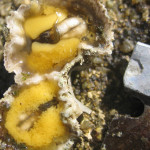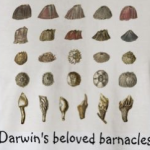![]() Spring is in the air! Its the time of year to release your gametes into the water and make baby barnacles. But wait a second, you are a permanent fixture on a rock. Can’t move. What is a young, lovestruck sessile she-male to do? Well, if you are hung like a barnacle you don’t really have to move that far.
Spring is in the air! Its the time of year to release your gametes into the water and make baby barnacles. But wait a second, you are a permanent fixture on a rock. Can’t move. What is a young, lovestruck sessile she-male to do? Well, if you are hung like a barnacle you don’t really have to move that far.
Barnacles are known as the John Holmes of the invertebrate world with penises reaching up to 10 times their body size. Not all barnacles are equally endowed though. To make the situation more complicated, barnacles are hermaphrodites. Eric Charnov proposed an extension of Sex Allocation Theory to simultaneous hermaphrodites, those individuals carrying both male and female reproductive parts at the same time. His model makes predictions for how much resources should be allocated in being male or female based upon how competitive your local environment. Thankfully for barnacles, being unable to move confines your locality to a rather small portion of rock. Or does it?
How much does a penis cost?
Barnacles tend to flock to one another, their larvae exhibiting what researchers call gregarious settlement. This results in dense mats of barnacles upon barnacles on rocky shores. New research from Matt Hoch, a PhD student at SUNY-Stony Brook, tests the effects of overcrowding and wave exposure on the penis morphology of the acorn barnacle, Semibalanus balanoides. But bigger is not necessarily always better as Hoch explains:
“Variation in barnacle penis traits may be important when comparing sex allocation of barnacles for several reasons. As the number of individuals in the mating group increases, mate competition intensifies, which is predicted to lead to greater relative allocation to male function. The penis itself represents a significant investment into male function, in terms of construction, maintenance and performance costs. For example, the presence of the penis, located between the feeding cirri on the terminal body segment, may reduce feeding efficiency. As penises grow larger, interference with feeding is expected to increase.”
For most of the year, the barnacle’s penis is rather languid. The vernal season for this little fellow is September to October where it rapidly grows until ready to spring into action come November. Unfortunately, the excitement of it all is short lived and the penis is cast off with the next moult upon mating. Because the growth and decay of the penis happens so quickly, Hoch hypothesizes that it is costly to maintain this one-use only appendage. If the closest neighbor is far away, it will need to invest more energy into maleness, resulting in a longer penis.
Crowding Penises
Hoch compared barnacles found in a crowd, when their shells were touching their neighbor’s (see photo above), to those in uncrowded situations. Studying barnacles in scenic Shinnecock Bay in Long Island, NY Hoch found that crowded barnacles had significantly shorter penises than its un-crowded bethren. Yet, the thickness at the base remained unchanged and there was no difference in the relationship between penis length and body volume between living arrangements. Additionally, as the distance between neighbor’s increased, there were fewer fertilized egg masses. So depending on you look at it the barnacle trades off size for action.

Barnacles take a lickin’ and keep on kickin’
The rocky intertidal is no place for a wuss. Tides and wave forces make it an intensely dynamic environment, not to mention stress from heat and drying out. One needs a “thick skin” in order to take the constant, rhythmic pressure of wave exposure. Hoch studied 2 sites at ole Shinnecock Bay. One was exposed to a higher frequency of waves, facing the Atlantic. The other site faced into the bay where it was more tranquil. As one can see from the above graph, fertilization is more successful in the protected area. The disparity of fertilization success between protected and exposed areas grows as the distance between neighbors increase. Exposure to waves appears to also hinder fertilization success. Is it because waves break off the barnacles penis? While there is no difference in penis length between areas, the basal diameter was thicker in exposed barnacles. The penis adapts to take a pounding by buffing up at the base.
What is the take home message here if you are a barnacle? If a barnacle’s goal is to be the John Holmes of sea world, live in uncrowded areas in wave-exposed environments. If the barnacle’s goal is to fertilize as many eggs as possible, live in close quarters at areas protected from wave exposure. I’m not quite sure which goal barnacle’s are seeking. They are cunning creatures with a knack for keeping their cirri to themselves.
What does this have to do with the deep sea? The deep sea is moderately protected from the wave exposure faced by intertidal organisms. Hoch provides an interesting hypothesis that, at least in barnacles, the physical environment plays a strong role in molding morphology. Such characteristics are said to be plastic. In order to understand how evolution of novel morphology arises, the degree of plasticity in the trait needs to be assessed. Reproductive morphology is typically considered to be under a high degree of selection, because it is directly associated with producing the next generation, among other reasons. Under Sex Allocation Theory, Hoch predicts that:
“… all other factors being equal, barnacles in areas protected from waves should have larger mating groups than those in exposed areas. The resulting functional mating groups will have higher levels of competition among functional males, leading to relatively greater investments into the male role. I would then predict that in areas exposed to waves, barnacles will invest relatively more energy into female function and produce larger broods of eggs. Given the higher number of males competing to mate with a single individual in areas protected from waves, individual broods are more likely to have a larger number of siring males and therefore greater genetic diversity among the offspring.”
Deep sea barnacles form similar aggregation to its intertidal cousins yet face little to no wave exposure aside from rarer events like underwater landslides. But there are local topographic highs in currents created by an outcropping. This may be as small as a lava wall (see below) or as large as a seamount. It would be interesting to see if Hoch’s predictions hold for gregarious barnacles in environments with similar conditions, but less of a physical force.
 Barnacles from a hydrothermal vent community. Note orientation tends to be on the vertical surface of the lava. Species mostly composed of Eochionelasmus ohtai.
Barnacles from a hydrothermal vent community. Note orientation tends to be on the vertical surface of the lava. Species mostly composed of Eochionelasmus ohtai.
—————————————————————–
HOCH, J. (2008). Variation in penis morphology and mating ability in the acorn barnacle, Semibalanus balanoides. Journal of Experimental Marine Biology and Ecology, 359(2), 126-130. DOI: 10.1016/j.jembe.2008.03.002







This reminds me of Randy Olson’s famous (at least, in certain marine biology circles) music video ode to the barnacle’s impressive endowment
Yes! That is a classic! And oh so soulful…
Hoch’s presentation at the Benthic Ecology conference had to be the single best attended talk outside of the daily keynotes. I believe there was actually a lottery for how many times the word penis could be mentioned in a 15 minute talk.
I saw his talk at the Benthic Ecology meeting in 2005. I thoroughly enjoyed it.
Did you see their doubly endowed barnacle?
So many questions….
I’ve been told by Matt that paper is coming out shortly. And yes, I will blog on that!
interesting . .. to study BARNACLES